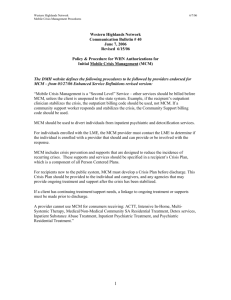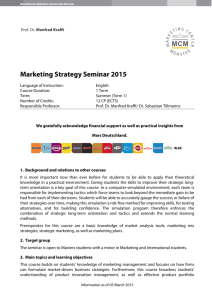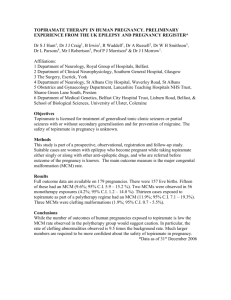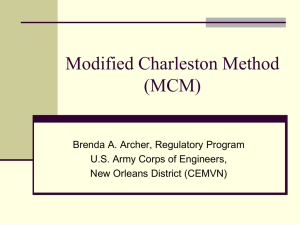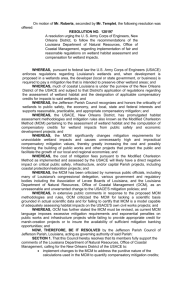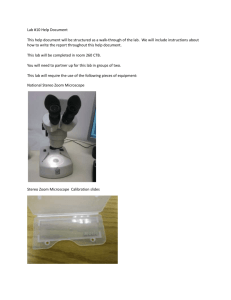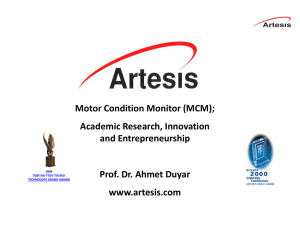Development of the Master Chemical Mechanism
advertisement
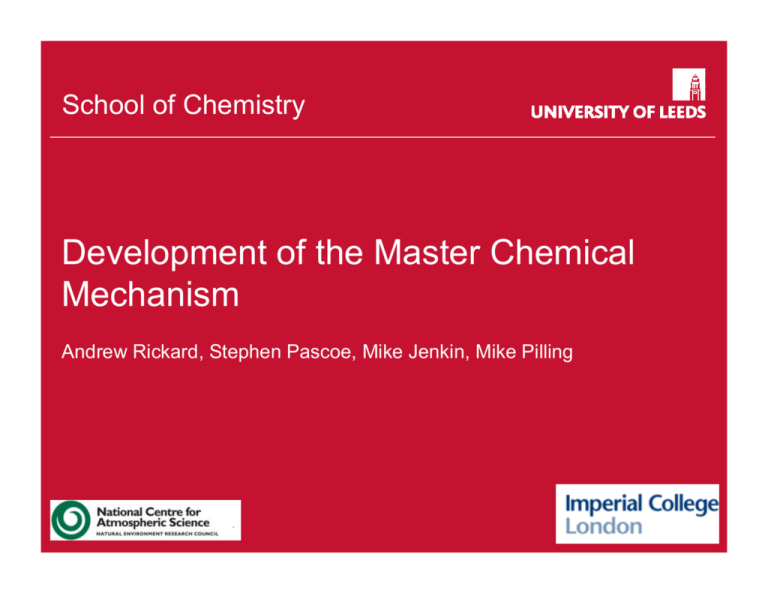
School of something School of Chemistry FACULTY OF OTHER Development of the Master Chemical Mechanism Andrew Rickard, Stephen Pascoe, Mike Jenkin, Mike Pilling MCM The Master Chemical Mechanism • The Master Chemical Mechanism is a large near-explicit tropospheric chemical mechanism describing the complete gas-phase degradation of primary emitted VOCs and the resultant generation of ozone and other secondary pollutants. • Covers ca. 70% of the mass emissions in the UK National Atmospheric Emissions Inventory (anthropogenic) and also contains some biogenics. • Commissioned by the Department of the Environment, DoE (Air Quality Division) – subsequently DEFRA, to improve the treatment of organic chemistry in ozone policy models. • Originally Developed by AEA Technology, Leeds, and the UK Met Office. • Widely used standard explicit mechanism for modelling studies of atmospheric processes. MCM Protocol Philosophy • To use information on the kinetics and products of elementary reactions relevant to VOC oxidation to build up an explicit representation of the degradation mechanisms. – resultant formation of ozone and other gas-phase secondary pollutants • apply measured and evaluated parameters (e.g. rate coefficients; branching ratios) from the literature where possible. • use analogy and ‘structure-activity relationships’ to define the other reactions and parameters. • strategic simplification limits number of reactions but retains essential features. Non-Aromatic M.E. Jenkin, S.M. Saunders and M.J. Pilling - Atmos. Environ. 31, 31 (1997) S.M. Saunders, M.E. Jenkin, R.G. Derwent and M.J. Pilling - ACP. 3, 161 (2003) Aromatic M.E. Jenkin, S.M. Saunders, V. Wagner and M.J. Pilling - ACP. 3, 181 (2003) MCM History 1996 MCM v1 - 120 VOC; 7000 reactions; 2500 species 1999 MCM v2 - 123 VOC; 10500 reactions; 3500 species 101 non-aromatic anthropogenic species 18 aromatics (provisional chemistry) 1 biogenic species (isoprene) 103 non-aromatic anthropogenic species 18 aromatics (extended provisional chemistry) 2 biogenic species (isoprene: α−pinene) 2002 MCM v3 - 125 VOC; 12700 reactions; 4400 species 104 non-aromatic anthropogenic species 18 aromatics (first rigorous representation) 3 biogenic species (isoprene: α−pinene: β-pinene) 2003: MCMv3.1 • The Current version, MCMv3.1, contains 135 primarily emitted species: 22 alkanes (C1-C12) 18 alcohols and glycols (C1-C6) 16 alkenes (C2-C6) 10 ethers and glycol ethers (C2-C7) 2 dialkenes (C4-C5) 8 esters (C2-C6) 2 monoterpenes (C10) 3 carboxylic acids (C1-C3) 1 alkyne (C2) 2 other oxygenates (C3) 18 aromatics (C6-C11) 15 chlorocarbons (C1-C3) 6 aldehydes (C1-C5) 2 bromocarbons (C1-C2) 10 ketones (C3-C6) c.a. 5600 species; 13500 reactions • Degradation schemes for 4 aromatics (BENZ, TOL, p-XYL and 135-TMB) have been updated on the basis of new kinetic and mechanistic data. • New MBO (2-methyl-3-buten-2-ol) scheme added (93 new reactions, 30 new species). • Extended list of chloro- and hydrochlorocarbons and 2 hydrobromocarbons. MCM Development of MCMv3.1 • Degradation schemes for 4 aromatics (benzene, toluene, p-xylene and 1,3,5trimenthylbenzene) have been updated on the basis of new kinetic and mechanistic data. • Performance of these mechanisms evaluated using detailed photo smog chamber data from the EU EXACT campaigns. • EXACT database contains photochemical smog chamber studies on all four mono-aromatics and experiments on specific key areas of aromatic oxidation, focusing on subsets of the toluene system. • This development work on mono-aromatics has been extended to update the degradation schemes of the 12 other mono-aromatics with saturated alkyl side chains in MCMv3.1. Heavily instrumented 200 m3 teflon foil chamber Long path FTIR – aromatic parent compound, O3, HCHO, HNO3 UV absorption – O3 ; DOAS – NO2, glyoxal Chemiluminescence – NO ; LIF – OH, HO2 Filter radiometer – J(NO2) GC techniques, HPLC, CO monitor MCM Protocol Structure Initiation reactions OH, NO3, O3, photolysis Approximate hierarchy of information sources Reactions of organic radicals reaction with O2 1) Experimental data (evaluated) Reactions of RO2 intermediates reaction with NO, NO2, NO3, HO2 and R’O2 2) Experimental data (direct) Reactions of RO intermediates reaction with O2, decomposition and isomerisation Reactions of Criegee intermediates excited and stabilised Removal of Cl atoms Reactions of degradation products 3) SARs (published) 4) SARs/analogy assumptions 5) Theoretical studies Simplifications Initiation criteria Channel probability Product degradation RO2 + RO2/R’O2 MCM scheme writing framework: Protocol Basis VOC initiation reactions photolysis OH reaction NO3 reaction O3 reaction carbonyls, ROOH, RC(O)OOH and RONO2 all VOC and oxygenated products alkenes, dienes, aldehydes and ethers alkenes, dienes, and unsaturated oxygenated products peroxy: RO2 excited Criegee [RC(OO)R'] stabilised Criegee RC(OO)R' stabilisation decomposition reaction with H2O, NO, NO2, CO and SO2 oxy: RO reactions of intermediates O2 reaction decomposition isomerisation reaction with NO, NO2, NO3, HO2, R'O2 oxygenated products products carbonyls, ROOH, ROH, RC(O)OOH, RC(O)OH, RONO2, PANs, multifunctional and CO MCM OH Radical Reactions Kinetics of OH + VOC/organic products • Rate coefficients have been measured for several hundred organics • Rate coefficients for ca. 2,000 species need to be estimated (e.g. SAR method of Atkinson, 1994; Kwok and Atkinson, 1995) Product radical distribution of OH + VOC/organic product • Mainly inferred from SAR partial rate coefficients • Scheme simplification measures applied in some cases - minor channels (<5%) ignored - single representative channel for ≥ C7 alkanes - so called ‘minor’ products (e.g. RONO2; ROOH) degraded to regenerate existing species MCM RO2 Radical Reactions Kinetics of RO2 reactions • Reactions with NO, NO2, NO3, HO2 and other peroxy radicals (R’O2) are included in MCM • There are about 1200 RO2 radicals in MCM v3.1 • Kinetic data are available for only ca. 20 RO2 – parameters assigned to majority of reactions by analogy and structure reactivity correlations Product branching ratios • Multiple channels for reactions with NO, HO2 and R’O2 • Scheme simplification measures applied in some cases - RO2 from ‘minor’ products react via single channel - RO2 + R′O2 reaction are necessarily parameterised (explicit chemistry for 1200 radicals would require 0.7 million reactions!) MCM RO Radical Reactions reaction with O2 O R O + O2 + HO2 R' R O decomposition isomerisation R R' O R' R + R' OH O R R' R • There are about 1200 RO radicals in MCM v3.1 • Relative importance of these modes of reaction largely defined by SAR methods of Carter and Atkinson (1989) and Atkinson (1997) R' MCM RO Radical Reactions acyl-oxy O R R + CO2 O α-carbonyl-oxy O O R' R R' R O O β-hydroxy-oxy OH OH R' R R' R O O α-alkoxy-oxy R O R' O R O R' O Simplification measure oxygenated RO radicals – exclusive decomposition assumed Chamber validation • Laboratory studies • Theoretical and semi-empirical methods e.g. rate coefficients, branching ratios, absorption spectra, quantum yields • Detailed mechanism construction Provides the link between Laboratory(MCM) studies and modelling • Scientific and policy modelling • Mechanism reduction Fundamental parameters Mechanism development Mechanism application MCM Some Applications • Modelling radical chemistry in support of field campaigns (ACSOE, PUMA, SOAPEX, NAMBLEX, TORCH and others. Mainly Leeds and York). • Modelling oxidant formation and the production and loss of oxidised intermediates (NAMBLEX, TORCH, ITOP. Imperial, Leeds, York) • Modelling SOA formation (Imperial). • Policy support to Defra, especially for O3 formation (Imperial, Met Office). • Modelling HCHO formation in the US and SE Asia, for comparison with satellite retrievals. Validation of emissions inventories (Harvard). • Modelling radical chemistry, for interpretation of NO3, N2O5 measurements (NOAA). • Development and validation of reduced mechanisms (Mainz, (Mainz Isoprene mechanism), Imperial (CRIMech), Leeds (objective reduction methods)). • Modelling chamber processes (Imperial, Leeds, Juelich, CEAM (Spain)) MCM Website http://mcm.leeds.ac.uk/MCM ● ● ● Menu Bar Mark species for later processing Three main functions – Browse – Search – Extract http://mcm.leeds.ac.uk/MCM Navigation: Search ● Enter SMILES string – ● e.g. isoprene: C=C(C)C=C Enter a MCM species name – e.g. n-butane: NC4H10 http://mcm.leeds.ac.uk/MCM Navigation: Search Results ● Structure image linked to reaction listing. http://mcm.leeds.ac.uk/MCM Reaction Listing http://mcm.leeds.ac.uk/MCM Extract Use Mark List as primary species Choose output format - HTML - FACSIMILE - FORTRAN - XML - KPP - (ASAD) http://mcm.leeds.ac.uk/MCM Feedback • Keep up-to-date with updates and improvements to the MCM and website • Provides a forum for suggestions and error reporting MCM The Future: Areas Requiring Revision • Development so far focused on mechanism development. • Updates tended to target portions of the mechanism only. • Some areas still based on 1990’s chemistry (Protocol 1). • Aimed mainly at boundary layer chemistry. • Difficult to update. Rate constants from SARs are hard-wired. • Not subject to peer review (except protocol papers). MCM Planned Developments • Over the next few years the MCM will be rigorously reviewed and updated. • A series of “modular” protocols are being developed to address a number of key areas: Initiation reactions (excluding ozonolysis and photolysis) - hydrocarbons and halocarbons (OH, NO3, Cl) - oxygenated species (OH, NO3, Cl, Br and isomerisation) Initiation by ozonolysis - including Criegee reactions Initiation by photolysis Reactions of RO2 intermediates - including isomerisation of RO2 Reactions of RO intermediates - including reactions with NO and NO2 T & p dependent MCM Planned Developments • The development of each of these protocols will be overseen by an international panel of experts established by ACCENT: MJ Pilling (Leeds), AR Rickard (Leeds), ME Jenkin (Imperial), RA Cox (Cambridge), J Hjorth (JRC, Ispra), W Mellouki (Orleans), L Vereecken (Leuven), R Atkinson (UCRiverside) and TJ Wallington (Ford Dearborn) • Database of updated rate constants is to be used by Luc Vereecken in order to develop SARs based on quantum chemical calculation. • MCM database will be extended to free tropospheric conditions (e.g. p dependence for photolysis, T for oxy reactions). • Automatic determination of T dependent rate parameters from SARs is being investigated through the development of structural recognition software (Leeds). MCM Photolysis Rates • In MCMv3.1 Photolysis rates for 26 core reactions (as a function of SZA) have been determined using the PHOTOL two stream isotropic scattering model (on 1st July (clear sky) at 0.5 km, lat. 45oN). • Variation of j with SZA is described well by the following expression: j = l (cosX)mexp(-n.secX) • 14 parameters are then used to define the photolysis rate of several thousand related species. • However, the laboratory measured cross sections and quantum yields for these core reactions have not been updated since 1997. • Updated measurements (higher resolution, better wavelength coverage) as well as new measurements have since become available. MCM Photolysis Rates • 26 photolysis processes defined • 14 parameters also used to define photolysis rates for several thousand other species MCM Photolysis Rates • A thorough survey of literature cross section (σ) and quantum yield (φ) data has been carried out in order to review and update the existing photolysis reactions in MCMv3.1. • The literature has been surveyed for new data to allow the list to be expanded, e.g. large (> C4) aldehydes, other carbonyls, bi-functional species, RONO2, terpene and aromatic products • Also, the relative contributions of multiple product channels should now be better defined in a number of cases (e.g. glyoxal) • Photolysis rates are calculated using the discrete ordinate radiative transfer model TUV4.2 (Madronich et al. 1998) which is freely available online: www.acd.ucar.edu/Science/Models/TUV/index.shtml • Cross-sections for many atmospheric photo-labile species are now available from the new MPI-Mainz UV-VIS Spectral Atlas: www.atmosphere.mpg.de/enid/2295 • The results of citable chamber simulations are also considered, particularly for species with uncertain parameters (e.g. data from the EU RADICAL project (Moortgat et al. (2002)) MCM Photolysis Rates • The Photolysis of ca. 54 species will be defined in the next version of the MCM: 14 C1-C7 straight chain and branched aldehydes (3 unsat.) 9 C3-C7 straight chain and branched ketones (1unsat.) 13 C1-C5 straight chain and branched alkyl nitrates 5 C3-C4 di-nitrates (2 unsat.) 4 α-dicarbonyls 3 nitro-ketones 1 organic peroxide 2 peroxy nitrates (PANs) 3 unsat. dicarbonyls MCM Photolysis Rates • The complete overview of photolysis rates will be made available via the MCM website (http://mcm.leeds.ac.uk/MCM) and published as a review protocol • A link to download the updated TUV4.2 model will be made available on the MCM website so that the user can calculate there own photolysis rates • Photolysis rates will be calculated (using TUV) under various representative atmospheric conditions (altitude, cloud cover, surface type (albedo)) • As well as tables and parameterisations of photolysis rates (with respect to SZA) recommended cross-section and quantum yields (as a function λ, T and p) will also be made available on the website. • In the light of new data, the choice and representation of surrogate parameters used to define photolysis rates and product distribution of reactions not currently known will be reviewed and any subsequent new chemistry evaluated (e.g. C3-C7 aldehydes). MCM Links to IUPAC (1) • IUPAC database provides kinetic and photochemical data evaluated by the IUPAC Subcommittee for Gas Kinetic Data Evaluation: www.iupac-kinetic.ch.cam.ac.uk • Many explicit rate constants in MCM come from IUPAC evaluated database. • European and US panel evaluation. MCM Links to IUPAC (2) • Knowledge Transfer funding received for the integration and codevelopment of the MCM and IUPAC databases (Leeds, Cambridge, BADC): o Development and synchronisation of the IUPAC and MCM databases in line with developments being made by the chemo-informatics communities using standardised formats and nomenclature so that data can be shared across each database and other community databases. o Ease of MCM maintenance enhanced by linking of IUPAC datasheets to the appropriate reactions in the database. o Common web-based tools will be developed for clear simultaneous searching of both databases and easy extraction of data. These updates will make the MCM more robust and sustainable and help it retain its reputation as a state of the art, highly detailed “benchmark” organic chemistry mechanism. MCM Implementation • The provision of a “benchmark” explicit chemical mechanism provides the basis for the development of reduced mechanisms for use in global models where a concise but accurate representation of the chemistry is needed (e.g. UKCA). • Such mechanism reduction and lumped methods derived from the MCM are: o “Common Representative Intermediates” Mechanism (CRIMech) (Jenkin et al. Atmos. Env., 36 (2002) 4725-4734) o Sensitivity and time-scale analysis (Whitehouse et al., Atmos. Chem. Phys., 4, (2005a) 2056-2025) • This work directly links the MCM to work being carried out in APPRAISE, QUEST(QUAAC) and UKCA.

